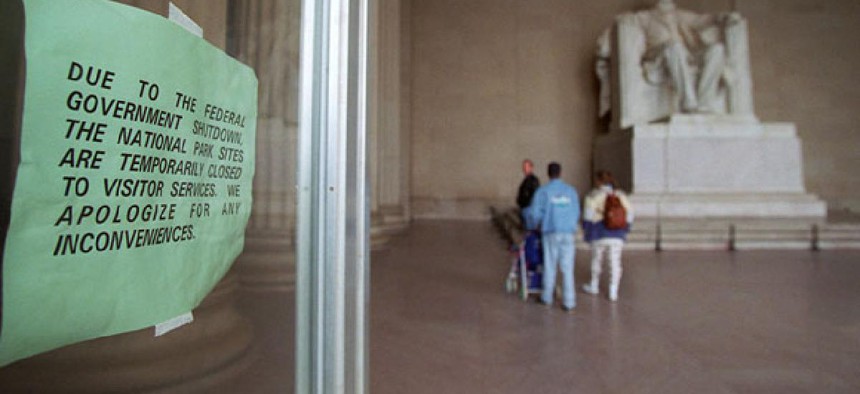
The federal government last shut down in the mid-1990s, affecting federal parks and monument staff. AP file photo
After the Sequester, Government Shutdown Looms
The continuing resolution keeping government open expires on March 27.
Congressional leaders are already shifting their focus to the next spending battle after the automatic budget sequester takes effect on Friday -- how to keep the government running -- but the Democratic strategy on this fight is far from set.
House Republicans are gearing up for a bill spearheaded by Appropriations Committee Chairman Harold Rogers, R-Ky., which would keep the government funded for the rest of the fiscal year at the post-sequester spending levels of $974 billion. That bill is expected to be brought to the House floor as soon as next week.
Meanwhile, Senate Democratic leaders are waiting to see what the House can pass and how the votes break down before devising their plans. Although Senate Democratic leaders are engaged in conversations with their House Republican counterparts about the expiring continuing resolution to fund the government, they have not communicated a strategy for handling the CR to the Democratic caucus.
“The discussion has definitely started to shift towards how the CR is going to be dealt with, and if the House sends something over, what can we expect it might look like and what we want to do about it,” said a Democratic Senate aide, who was not authorized to discuss the dynamics on the record. “I don’t think Democrats know what we are going to do with that. Are we just going to raise the levels and put in more details on the discretionary side or what?”
“We have not heard much of a coherent strategy from our leadership,” the aide said.
Democrats are still focused on trying to gain leverage through the sequester, in hopes that those cuts are perceived to be so damaging that voters react, triggering needle-pushing opposition to them. Such momentum would be necessary to bolster Democrats’ hand for returning spending levels to pre-sequester levels, said Hill aides and budget wonks following the issue.
“We feel pretty confident about our messaging looking past the sequester and towards the CR -- that if Republicans are coming in at this lower number, that we will have some kind of a better story to tell about how we are still working to replace sequestration and we will be able to fund defense and nondefense at higher levels,” said another Democratic Senate aide.
But Republicans see the sequence of these spending battles in their favor. With sequestration hitting first, a new, lower fiscal baseline is set that will help the GOP resist any spending increases that the other side might propose. “Republicans don’t get to run everything, but what they can do is stop increases,” said Grover Norquist, president of the influential Americans for Tax Reform.
The current CR expires on March 27. If Congress does not act before then, the federal government faces the threat of a shutdown that could be politically devastating for whichever political party is held to blame.
NEXT STORY: Play of the Day: The Sequester and The Oscars






